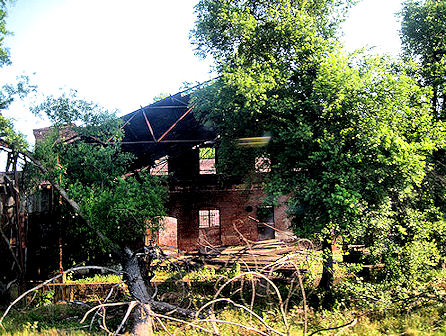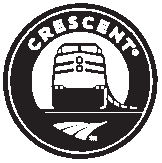|
The Trip on the Train
For those who came in late, I decided to run down to New Orleans to get a first-hand look at the oil spill and its effects. I had previously been thinking about taking an overnight train trip - just to be able to write about it. The combination of the long-weekend, the existence of a direct train between Washington, DC and New Orleans, and a suggestion by Mullfave Mary Matalin that I get on down to Nola to look at what's going on was enough of a stars-have-aligned thing that I booked a trip on Amtrak's "Crescent" which runs daily from New York to New Orleans with stops in Washington, DC, Atlanta and 30 other cities and towns along the way.
If you missed the opening chapter of this Travelogue, you can catch up by clicking HERE.
The train was due into Alexandria, Va at 6:49 and showed up just about on time. I boarded, was shown to my bedroom and got settled in.
On a standard sleeper train there are about a dozen sleepettes, two bedrooms and one "accessible" bedroom which is larger than the other two allowing room for a wheel chair. The accessible bedroom was available and offered so I took it.
This is a photo from the doorway looking at the seats:
That's my backpack settling into the window seat before I even before I had the chance to shout "Dibs!"
This is a 27 hour trip so I knew I was going to have sunshine issues at some point. We headed mostly south and SSW so, by firing up my iPad and getting a good GPS fix on our position I carefully calculated that the sun would be streaming into my window in the afternoons.
When I was in second grade Miss Carla told us we could learn our right from out left by saying to ourselves "I write with my right." I, however, am left-handed and that off-handed remark has haunted me for lo these many decades.
Not only that, but I am spatially challenged which means I can't turn shapes around in my head. In order to read a map I must turn it to the direction I am going. Just now, for instance, I had to draw a little compass on a piece of paper, and twist it so that South was up, just to remind myself which way was West when I was sitting in the train.
Explains a lot, huh?
After the car porter (Ryan) showed me the light switches and assured me he was at my beck-and-call at any point during the trip, I made my way to the dining car.
Amtrak has found a pretty good balance between the formality of the dining cars of the 30's and 40's and the cafe cars we are more used to on the Northeast Corridor trains which are effectively a snack bar on wheels.
Here's a typical table set for lunch:
The tablecloth is not linen, but is a disposable fabric. It's white and it works. The napkins are cloth and the silverware wrapped within are metal, not plastic.
The plates on which the food is served are plastic, but more like Melamine than like that squishy plastic stuff you get at the ballpark.
The food itself is OK. There are standard menu items (scrambled eggs for breakfast, burgers for lunch, and steak for dinner) plus "specials" every night.
If you want to see a PDF of the actual menu, you can click HERE.
When I walked into the dining car and elderly gentleman asked me if I were by myself. I said I was and he showed me to a table, like the one above, that already had three people who had just been seated. Unlike a restaurant where you can have a table to yourself, if you want, the train tradition is to sit with whomever, and strike up a conversation.
When I announced that I was taking this trip, someone wrote to me saying I should leave my bedroom and spend some time in the café car "where the action is." I thought to myself, "If I wanted 'action,' I'd have had dinner at Landini's with the MD of S&P and flown down on Friday morning." As it turns out, I did spend some time in the café car if only because I wanted a change of scenery from my room.
When I am on the road by myself, which is about 98 percent of the time, I like to read while I eat by myself. That was the real reason for the Kindle and now for the iPad. My social skills rank just behind that of a self-centered ficus tree. I brought my iPad to the dining car, but left it in my lap because it would have been beyond even my capability for rudeness to sit and read while the others were happily chatting about this 'n that.
At that first night's dinner, I was the only overnight train rookie. The two women were cousins who live in NYC but have family someplace in southern Virginia so they take the Crescent with some regularity. The guy sitting across from me travels between Washington, DC and NYC and so has gathered enough Frequent Trainer Points (I think they're actually called "Guest Reward" points) to take trains all over the place.
He said he sits in coach so save miles making me shudder through my crab cakes which were the chef's special for the evening.
If you have sleeping accommodations - bedroom or sleepette - meals are included, much as flying first class.
Oh! A Mullster properly pointed out to me that whining about the one-way train fare being about $650 while my airfare back was only about $300 was farely unfair, because I was, in effect, paying for first class transport on the train but coach travel on the plane.
I just looked it up. If I'd booked first class Sunday on the Delta flight from New Orleans through Atlanta to Reagan National, the one way fare would have been $830.40.
Good catch.
You may remember that I bought two bottles of wine and about $20 worth of candy in case I found I was dying of (a) thirst or (b) a sugar low.
I also stocked up my iPad with about a dozen black-and-white movies ranging from Charlie Chan mysteries to film noir favorites. I had meant to load up my collection of Hopalong Cassidy masterpieces, but I never got around to that.
You can see the mostly empty wine bottle, the Charlie Chan film on the iPad and whatever I was doing on my laptop in the lower left-hand corner.
The candy stash was on the seat next to me - never far out of reach.
Ryan the Car Porter made up my bed while I was at dinner so I used my backback as a backboard - which works very well. The trick is to place your backpack (front to the wall) which presents a flat surface against which to lay your body. If you happen to have a pillow or pillows, you stack them between you and the flat surface and voila the perfect position to read and/or watch Charlie Chan movies. The only problem was there was no good place to put the wine, but I decided that was a small price to pay not to be sitting up in a coach seat all night.
Here's what the bench looks like when made up as a bed. I didn't have my backpack in place in this photo, but you can see how it would have worked.
After a very good night's sleep (my iPad turned itself off after the movie I was watching finished, even though I had fallen asleep well before the ending) I went into my personal bathroom, shaved and showered (which involves a hand-held nozzle with the water draining through the floor) and put on fresh clothes.
I wasn't certain where we were but I had three different devices with GPS capes, but only two of them work outside of a cell phone signal.
A sidebar about cell phones: There are a lot of places in the country which do not have cell phone service. Either that, or the few areas without cell service all happened to be along the Crescent's route. This was important because Thursday night is a writing night for MULLINGS and I need to be able to look things up on the Internet, upload the column and the Secret Decoder Ring pages; and send the issue to the 35,000 or so people who are on the e-mail database to receive MULLINGS.
What I did was keep an eye on the upper left-hand corner of my iPad which shows the communications status of the device.
In this photo which is a close-up of the corner of the screen, and which I took sitting at my desk The "Pages" icon is Apple's version of Microsoft's "Word." I have not yet mastered Pages.
What I did was to type like crazy while there was no cell service (there was never any Wi-Fi available on the train) and make notes about that I needed to look up when the iPad showed there was cell service.
I have a Verizon "air card" for my laptop, so I didn't need the iPad to access the Internet. In this case I was using it as an $800 cell service sniffer.
Through rural North Carolina, Georgia, Alabama and Mississippi the only time there was cell service is when we were speeding through (or more rarely, stopping in) a town. Problem was, in the dark there was no way to tell when a town was coming up (and cell service would be available) so I multi-tasked by also using my iPad's GPS capabilities which doesn't need a cell signal to work. I kept the screen on the Maps program which has a little blue dot tracking where we were. In that way I could tell if I had a half hour, or five minutes before I could upload to or download from the Internet.
After I'd gone through my morning ablutions I again checked the GPS to check our location. We were Ar and Dp stops gives the train a chance to make up some time if it has to. A train, like an airplane, can leave late but it can't leave early because there would be no way to alert passengers of an early departure. So, if we'd pulled into Atlanta at 8:20, we could still leave at 8:38 and make up the 17 minutes.
El Al, in my experience, doesn't do that. When everyone who is supposed to be on the plane is on the plane, they back away from the gate and head out to the runway.
At breakfast I saw with two ladies who did not know one another, but now that I was in my full "Train" mode, I didn't bring any reading materials. We had an excellent conversation ranging from the oil spill in the Gulf to the necessity of making "texting-while-driving" a capital offense.
As I finished breakfast (scrambled eggs, sausage, biscuit, coffee) we were near Atlanta and, in this Here's a look down the side of the train.
The Mullings Director of Standards & Practices asked me if I would ever do that trip in a coach seat. I said I would have left the train in Atlanta and flown to New Orleans which, of course, was a lie. What I really would have done was to get off the train where ever we were at about 11 PM call for a cab to take me to the nearest hotel, sleep in, and figure out how to get to New Orleans when I awoke.
The problem with getting up and having breakfast at about 7 AM is there are still twelve-and-a-half hours to go before New Orleans.
Given my history of flying in C-130s, travelling in Humvees, and hanging around places like Iraq and Afghanistan it may come as something of a surprise to learn that I am given to motion sickness. A lot.
Over the years I have trained myself to fall asleep the instant the captain concludes his drawling announcement that we're about to experience a light chop for the next twenty minutes so he's turning the seatbelt light on and wants the flight attendants to pause the cabin service and take their seats.
For me, there is no such thing as a "light chop." It's either smooth sailing or a frantic search for that white bag in the seatback pocket.
A train trip in America is at least a "light chop" all the way. Except when the train is stopped. That meant I could watch a movie without too much distress and take this photo of an abandoned building south of Atlanta, but typing on Friday turned out to be a stomach churning endeavor and so I gave it up.
I wasn't certain how I had gotten through typing on Thursday night, and when I mentioned it to the waiter in the dining car at lunch he told me that the tracks between Atlanta and New Orleans weren't nearly as good as the tracks between New York and Atlanta.
That tells me we're still a couple of weeks away from a functioning bullet train system in the U.S.
Even though I spent most of Friday in a minor motion-sickness-induced haze, I got myself organized well enough to make a bunch of phone calls so the trip down to Plaquemines Parish the next day would be worthwhile but that was about it.
Wanna hear something curious? As I was writing about that wooziness just now, I found myself reliving the feeling. Hmm.
Although I thought we had gotten about 45 minutes behind schedule, we pulled into New Orleans only about 10 minutes past our listed arrival time of 7:38 PM. The New Orleans train station is bright and clean; I walked outside, was in a cab within three minutes, and checking into my hotel by 8:15 PM.
Glad I did it. Glad it was over.
Final thoughts.
I'm glad I took the Crescent, but I don't think I'd do it again. At least not alone. Although I have been known to sit in my den for an entire weekend, leaving only to go to the kitchen and/or the bathroom, that is my choice. If I want to, I can get up and drive somewhere, ride my scooter somewhere, or walk somewhere. On a train you can only go up and back and, like at Atlanta, step off the train for 20 minutes.
Also, there is no on-board entertainment. On many airplanes you can watch recent movies or even live TV. There is also Wi-Fi available for purchase on most domestic flights. Airlines don't invest in those systems to please the passengers; they are money-makers and Amtrak should begin looking into bringing its long haul trains into the 21st century.
Although my story about the condition of the tracks was tongue-in-cheek, it was also a true story. As a nation we should begin investing in tracks which can handle high-speed trains. The railroad rights-of-way, dating back to the 19th century, were largely land grants from some government or
another which wanted a rail line to go through a specific place, or were purchased using the right of eminent domain - meaning landowners were forced to sell to the railroad whether they wanted to or not.
We keep hearing about the need to upgrade our electricity distribution grid which, in many places, hasn't changed since Thomas Edison built it. Same goes for America's railroads.
If real unemployment is going be around 18 percent for the foreseeable future, making it a national priority to upgrade our rail system - from the tracks on up - and hiring people to accomplish that, might be a pretty good use of government funds.
-- Rich Galen
Click here to return to the Secret Decoder Ring page
|
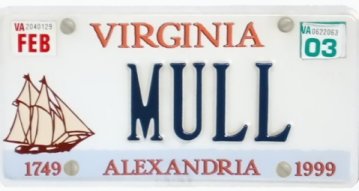

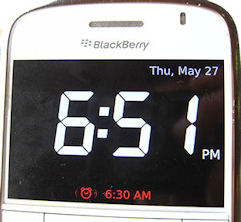
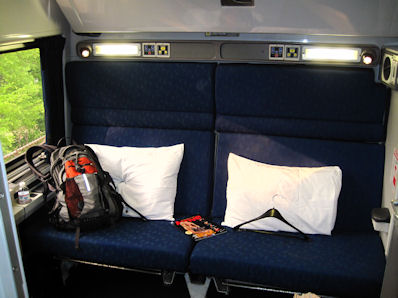
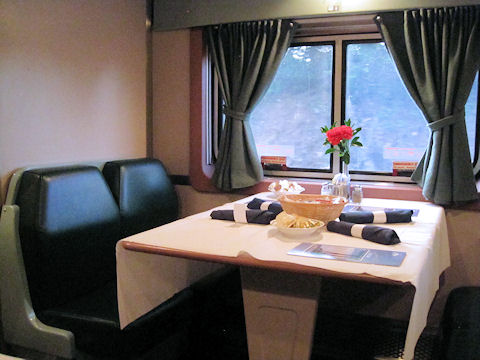
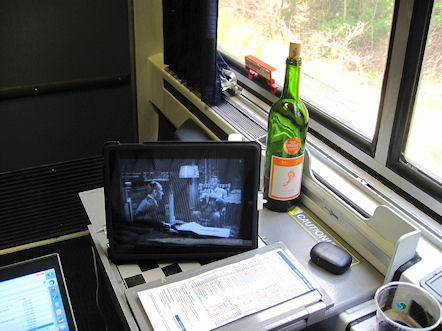
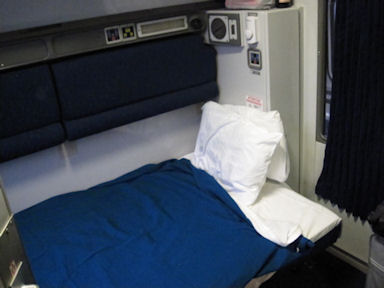
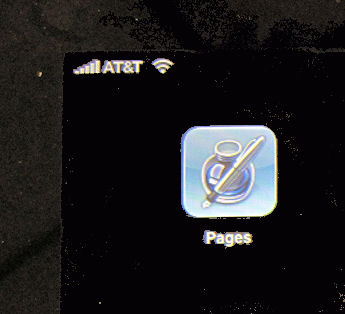 on Tuesday morning, you see that I am getting a strong 3G signal from AT&T and I am also connected to the office Wi-Fi network (that symbol to the right). The number of bars and the number of arcs tell you the strength of the signals.
on Tuesday morning, you see that I am getting a strong 3G signal from AT&T and I am also connected to the office Wi-Fi network (that symbol to the right). The number of bars and the number of arcs tell you the strength of the signals.
 about an hour outside of Atlanta which is the first major stop - major meaning the schedule shows an "Ar" time and a "Dp" time. In Atlanta the stop, as you can see, is scheduled for about 25 minutes from 8:13 to 8:38 AM.
about an hour outside of Atlanta which is the first major stop - major meaning the schedule shows an "Ar" time and a "Dp" time. In Atlanta the stop, as you can see, is scheduled for about 25 minutes from 8:13 to 8:38 AM.
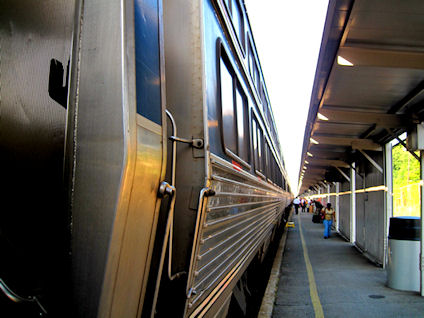 case we were on schedule so we would spend the full amount of time in the station. I got off the train and walked around the platform to stretch my legs.
case we were on schedule so we would spend the full amount of time in the station. I got off the train and walked around the platform to stretch my legs. 